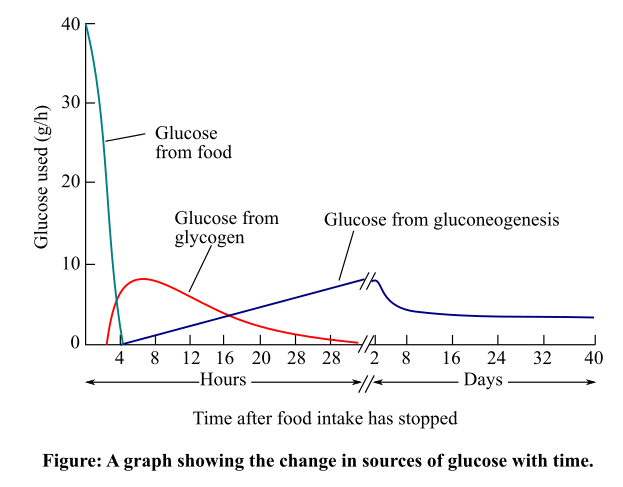
To review:
The mechanism used by the human body for supplying glucose to its organs when food intake stops.
Introduction:
The main source of energy in the human body is glucose. The human body gets glucose from food. The body stores the glucose as glycogen. The human body uses this glycogen as a source of glucose when there is lack of glucose intake. When the stored glycogen is used up, the body uses other molecules as a source of glucose, which involves the process of gluconeogenesis. The graph showing the ways, by which the human body cells shift in their rate of glucose oxidation and the source of glucose oxidized after food intake has stopped is given below:

Explanation of Solution
When the food intake stops for a long time, then gradually the reserve glycogen that was used as the source of glucose declines. Then, the liver along with the kidneys produce glucose by using other molecules. These molecules include glucogenic amino acids, lactate, and glycerol. This process of producing glucose by using other molecules is known as gluconeogenesis.
The liver also uses some other sugars, such as sucrose and galactose as a source of glucose. The liver produces
Therefore, it can be concluded that the human body uses other molecules as a source of glucose to fulfill the need for glucose in its organs. This process is known as gluconeogenesis.
Want to see more full solutions like this?
Chapter 9 Solutions
Life: The Science of Biology
- A person has undergone fasting. What type of feedback mechanism is exhibited by his body to sustain his blood sugar and for it not to drop in critical level even though he is not consuming enough carbohydrates to sustain his normal blood sugar level?arrow_forwardAnimals store glucose in the form of_______?arrow_forwardHow does the body maintain energy substrates to tissues during starvation using the liver, muscles and glucagon in your response?arrow_forward
- . Does the penguin or the mouse expend a greater proportion ofits energy budget on thermoregulation? Why?arrow_forwardMake a flowchart that indicates the pivotal intermediates through which glucose can be converted to fat.arrow_forwardWhen the body lacks insulin and cannot burn glucose for energy, what doesthe body use as fuel instead?arrow_forward
- Discuss that an adult animal consumed 50 kcal of food. 5 kcal have been excreted in urine and feces. Where did the remaining 45 kcal eventually go?arrow_forwardSuppose you are measuring the metabolic rate of a young,growing cow by using the material-balance method. Whatprocedures could you use to take account of the cow’s growth, sothat you measure a correct metabolic rate?arrow_forwardOn a per-kilogram basis, why does a small mammal such as a shrewrequire so much more energy than does an elephant or other largemammal?arrow_forward
- With the aid of a diagram describe the control of blood glucose levels in the fasting state and post consumption.arrow_forwardIf a zoo animal eating ample food shows signs of malnutrition, how might a researcher determine which nutrient is lacking in its diet?arrow_forwardPancreatic cells secrete insulin (a hormone) to help control blood sugar levels by what process?arrow_forward
 Biology (MindTap Course List)BiologyISBN:9781337392938Author:Eldra Solomon, Charles Martin, Diana W. Martin, Linda R. BergPublisher:Cengage Learning
Biology (MindTap Course List)BiologyISBN:9781337392938Author:Eldra Solomon, Charles Martin, Diana W. Martin, Linda R. BergPublisher:Cengage Learning Human Physiology: From Cells to Systems (MindTap ...BiologyISBN:9781285866932Author:Lauralee SherwoodPublisher:Cengage Learning
Human Physiology: From Cells to Systems (MindTap ...BiologyISBN:9781285866932Author:Lauralee SherwoodPublisher:Cengage Learning BiochemistryBiochemistryISBN:9781305577206Author:Reginald H. Garrett, Charles M. GrishamPublisher:Cengage Learning
BiochemistryBiochemistryISBN:9781305577206Author:Reginald H. Garrett, Charles M. GrishamPublisher:Cengage Learning- Nutritional Sciences: From Fundamentals to Food, ...Health & NutritionISBN:9781337486415Author:McGuirePublisher:Cengage



